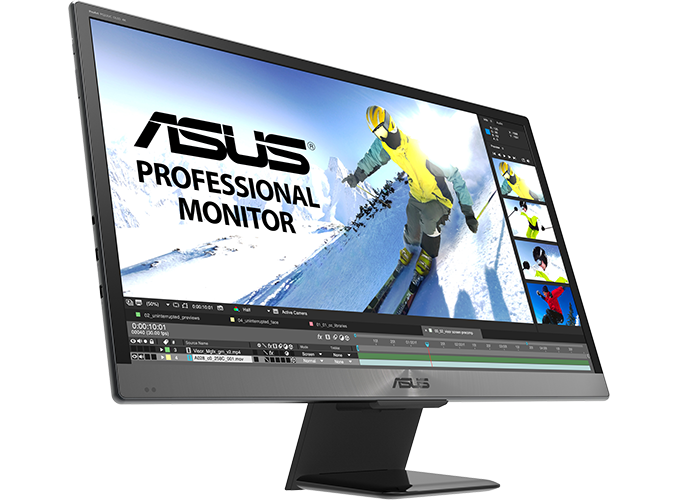ASUS Unveils ProArt PQ22UC OLED Monitor: 4K, 99% DCI-P3, 0.1 ms Response Time
by Anton Shilov on January 10, 2018 3:00 PM EST- Posted in
- CES 2018
- Displays
- Asus
- Trade Shows
- 4K
- Monitors
- OLED
- HDR
- ProArt
- ProArt PQ22UC

LAS VEGAS, NV — ASUS has announced its first professional OLED display at CES 2018. The ProArt PQ22UC features a 4K resolution and covers 99% of the DCI-P3 color space, making it a good solution for professionals who need this spectrum. ASUS says that the compact dimensions and light weight of the device make it a good option both for post-production and on-set routines.
The ASUS ProArt PQ22UC is based on a 21.6” 4K RGB stripe OLED panel made by JOLED (a joint venture between Sony and Panasonic) using the company’s printing method. The panel features a 3840×2160 resolution, a contrast ratio of 1,000,000:1, and a response time of 0.1 ms. The monitor can reproduce 1.07 billion colors and covers 99% of the DCI-P3 color space. ASUS does not say anything about the brightness of the panel, 3D LUT, sRGB, and Rec. 2020 support. The company does say that the “dynamic range is wide enough to support HDR content”, so the look-up tables are there, but it is unknown whether the PQ22UC supports the HDR10 or other high dynamic range specs. In any case, HDR requires relatively high brightness levels and luminance is not a strong side of the OLED technology in general, so the actual HDR experience on the PQ22UC is something that remains to be seen. Meanwhile, 3D LUTs can be used on set to emulate specific display devices for quality assessments.
ASUS positions the ProArt PQ22UC as a professional solution for those on the go, which is why it uses USB Type-C and micro-HDMI inputs (no word on exact protocols, but DP 1.2 and HDMI 2.0x are likely) to save space. The display features an angled stand that can regulate height & tilt and can be detached and folded flat for easier transportation.
| Brief Specifications of the ASUS ProArt PQ22UC | |
| PQ22UC | |
| Panel | 21.6" OLED |
| Native Resolution | 3840 × 2160 |
| Maximum Refresh Rate | 60 Hz (?) |
| Response Time | 0.1 ms (black to white) |
| Brightness | typical: unknown minimum: 0.0005 cd/m² (minimum) |
| Contrast | 1000000:1 |
| Viewing Angles | 178°/178° horizontal/vertical |
| Pixel Pitch | 0.1245 mm² |
| Pixel Density | 204 ppi |
| Display Colors | 1.07 billion |
| Color Gamut Support | DCI-P3: 99% sRGB/Rec 709: 100% (tbc) Adobe RGB: ? SMPTE C: ? Rec2020: ? |
| Stand | Tilt and height adjustable |
| Inputs | 1 × USB Type-C (DP 1.2?) 1 × mini HDMI (2.0a? 2.0b?) |
| PSU | External |
| Launch Price & Date | unknown |
The display is factory calibrated to Delta E≦2 color accuracy and comes with the ASUS ProArt Calibration feature that saves color parameter profiles to the monitor rather than to a host PC, which is particularly useful for a mobile solution that can be attached to different computers.
ASUS has not released any details regarding pricing and availability timeframes of the ProArt PQ22UC. Meanwhile, JOLED says that its 21.6” 4K OLED panels are in production.
Related Reading:
Source: ASUS











25 Comments
View All Comments
Alistair - Thursday, January 11, 2018 - link
not until Q3 now apparantly, those are not coming out anytime sooniwod - Thursday, January 11, 2018 - link
I think most people miss the most important part of the announcement, which isn't about ASUS.JOLED are finally shipping!. It is possibly the only hope the OLED screen will ever come down in price that most consumer can afford them. By afford it doesn't mean cheap, it wont even touch IPS price level in 2022, but at least for a slight premium it should be close within 3 - 4 years.
LuneTech - Tuesday, February 13, 2018 - link
I want to get this, but I'm gonna have to put the strictest screensaver on to prevent burn in.davidwinst - Wednesday, April 25, 2018 - link
Finally an RGB-OLED Display! Unlike LG's crappy W-OLED TV's that distort colors to a White Hue. I can't wait until RGB-OLED will reach TV Screens, because CRT's and Plasma's all used RGB Spectrum Light, and that is why the picture quality on those are so superior to LCD and W-OLED. Long live RGB-OLED!!!lilkwarrior - Saturday, December 29, 2018 - link
Uh… what is currently touching W-OLED TVs that are the top picture quality TVs in the world w/ LG & Sony leading the way?RGB-OLED is an improvement, but don't act like LG's screens are "crappy" they'e unanimously among the best displays in the world!